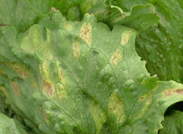
The moist weather pattern now affecting Arizona in general and Yuma County in particular
is providing the environmental conditions needed for downy mildew development on
crops susceptible to this plant disease. Rainfall in the vegetable production regions
of Yuma County on Monday, Jan 4th ranged from about 0.1 to 0.2 inches, with additional
rainfall predicted. These periods of rainfall plus the associated high relative
humidity provide ideal conditions for rapid development of downy mildew. Disease
severity is a function of the duration of plant wetness, with more nights and following
mornings with wet plants resulting in increasing disease. If not already initiated,
now is the time to start a preventative fungicide application program for downy
mildew on susceptible crops. Waiting until the symptoms of downy mildew are visible
before beginning fungicide applications can result in a less than satisfactory level
of disease management. By the time downy mildew lesions are observed, many more
are likely to be present but have not developed to a sufficient extent to be visible.
Fungicide evaluation trials conducted at the Yuma Agricultural Center as well as
in other states have demonstrated statistically significant reduction in disease
by application of fungicides such as Actigard, Aliette, Cabrio, Curzate, Forum,
Manzate, Orondis, Presidio, Previcur Flex, Prophyt, Ranman, Reason, Revus, and Tanos.
Several different modes of action are represented by these compounds, thus facilitating
alternation among different chemistries for effective disease management as well
as pathogen resistance management. Periods of low relative humidity and little or
no dew on leaves will help arrest downy mildew development. However, constant vigilance
is needed, as future occurrences of dew and rainfall will favor further development
and expansion of downy mildew activity.
Click picture to listen to Mike's update




